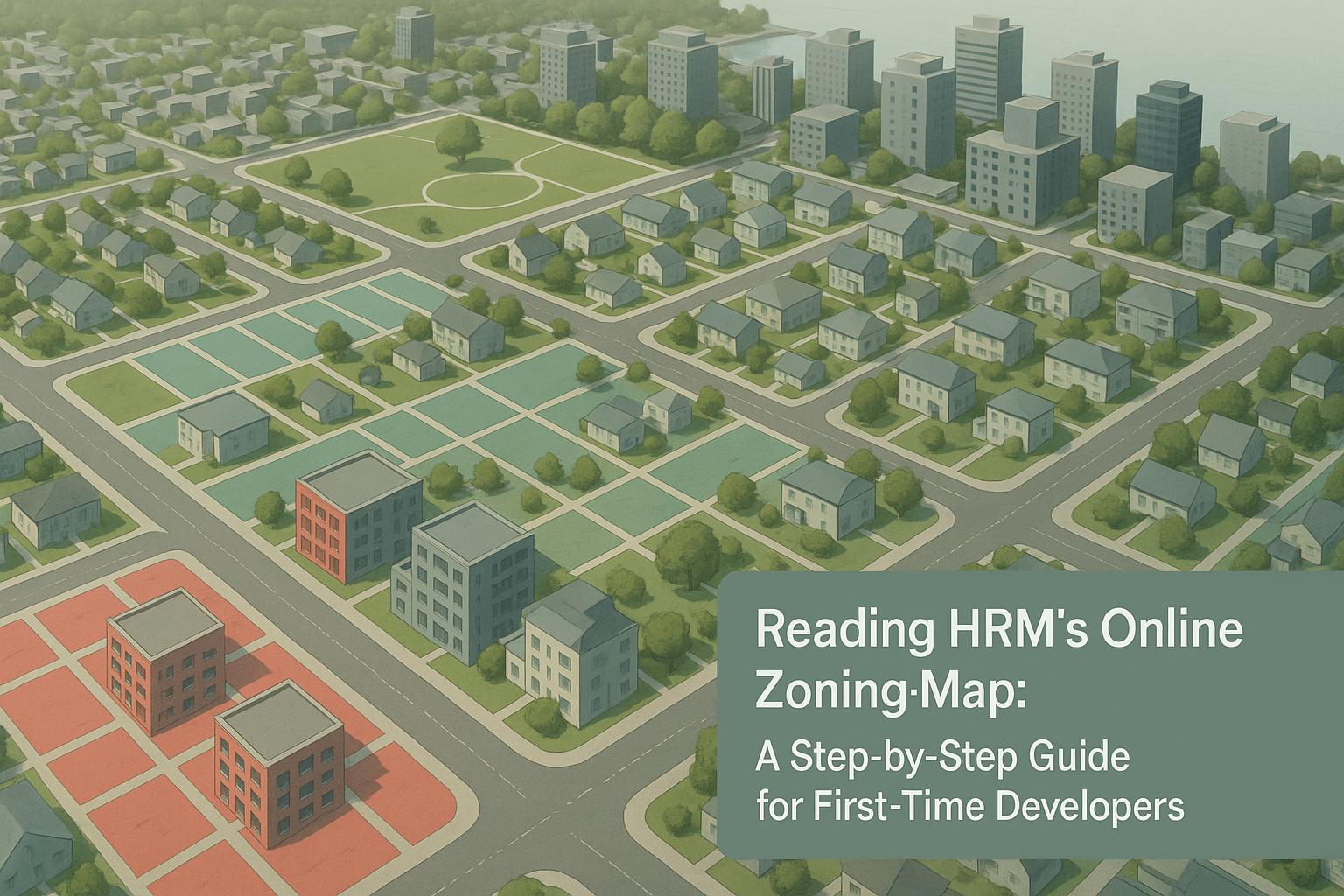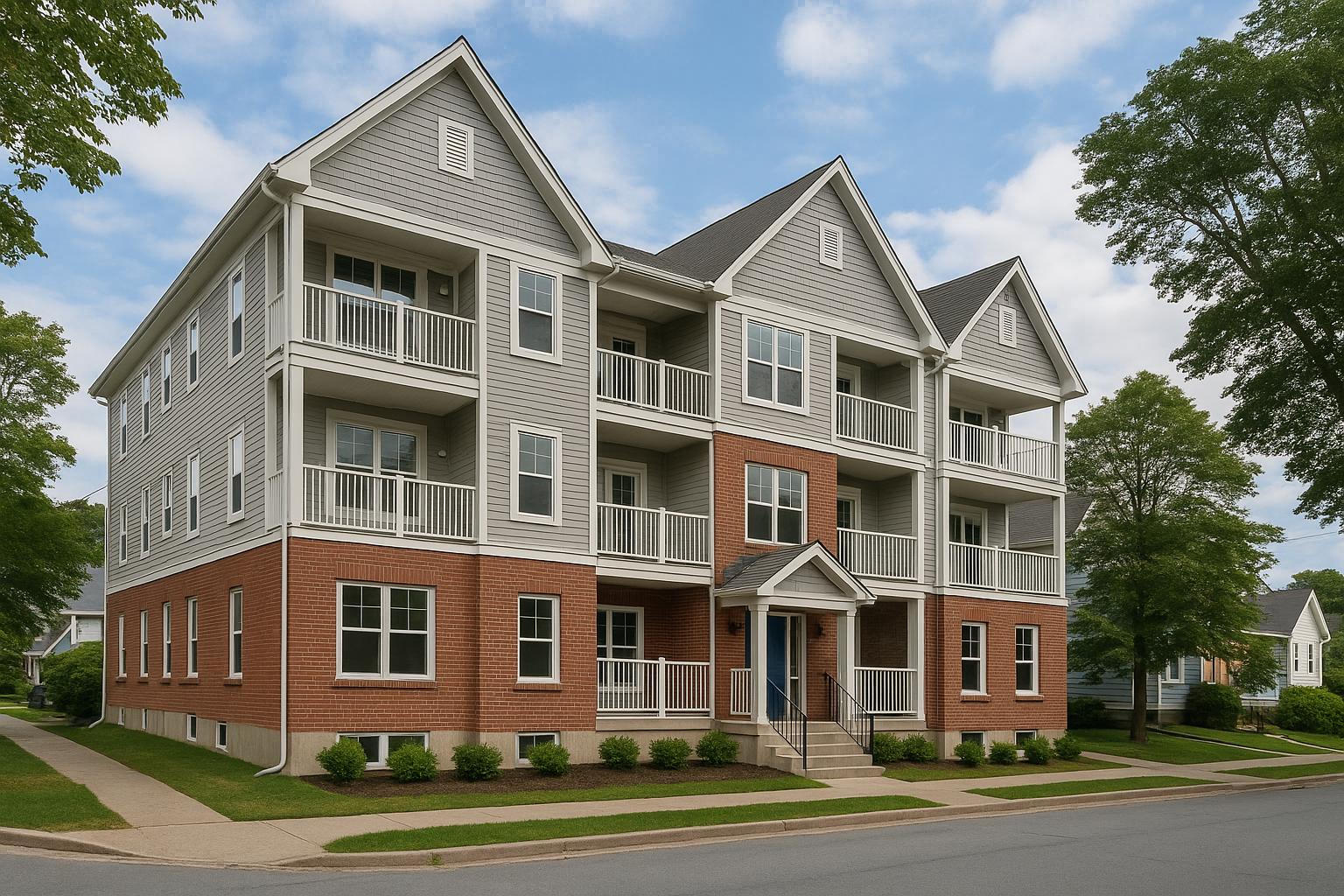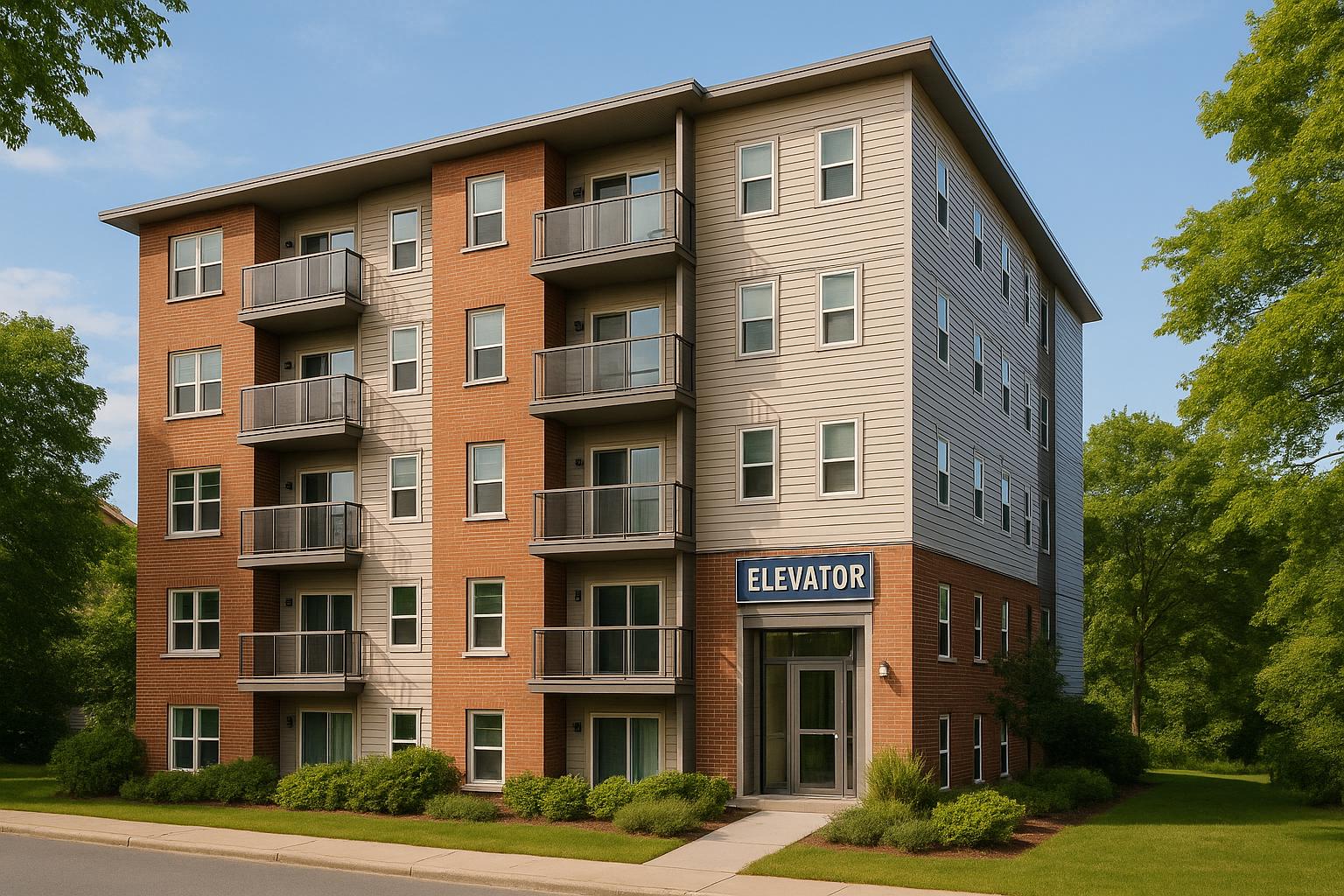Building a fourplex with a backyard suite under Halifax's ER-3 zoning is a smart way to maximize property income while staying within zoning rules. This zoning allows up to five rental units on a single property, combining a four-unit building and a backyard suite. Here's what you need to know:
-
Key Features of ER-3 Zoning:
- Permits low-rise buildings up to four storeys.
- Allows a mix of housing types, including backyard suites.
- No parking is required for backyard suites, reducing costs.
-
Backyard Suite Rules:
- Maximum floor area: 90 m² or accessory building limit, whichever is smaller.
- Simple approval process: Only a building permit is needed.
-
Construction Costs:
- Fourplex: $640,000–$800,000 ($160,000 per unit).
- Energy-efficient upgrades (CMHC MLI Select): Adds $40,000 per unit but enables 95% financing with a 50-year amortization.
-
Rental Income Potential:
- Monthly: $9,750–$10,500 for all five units.
- Annual: $117,000–$126,000.
- ROI: 12%–20%.
-
Planning Tips:
- Position the main building at the front and the backyard suite at the rear for optimal use of space.
- Use energy-efficient designs for better financing and tenant appeal.
- Submit accurate plans and documents to avoid delays in municipal approvals.
Choosing an integrated design-build approach can save time and reduce costs by offering fixed pricing and guaranteed timelines. With careful planning and execution, this project can provide strong returns and steady cash flow.
Case 24062 - 209 Kearney Lake Road
ER-3 Zoning Rules and Requirements
Halifax's ER-3 zoning provides property owners with the opportunity to develop multi-unit rental properties while maintaining the character of the surrounding neighbourhood. Understanding these regulations is key to meeting municipal standards and avoiding potential project delays.
What You Can Build Under ER-3 Zoning
ER-3 zoning allows for a variety of housing types, including single-detached homes, duplexes, semi-detached houses, townhouses, and low-rise apartment buildings. This range of options enables you to design projects that align with your lot's features and your investment objectives. A popular choice among property owners is combining a four-unit main building with a backyard suite, creating up to five rental units on a single property.
Backyard suites became a permitted feature throughout the Halifax Regional Municipality following a council decision on September 1, 2020[1]. This change was introduced to encourage affordable housing and foster connected, inclusive communities.
Size and Placement Rules
ER-3 zoning outlines specific height, setback, and lot coverage rules to guide your project design. For instance, four-unit buildings can be as tall as four storeys, offering flexibility in the layout and number of bedrooms. Setback rules ensure proper spacing between buildings, while lot coverage limits help maintain green spaces and parking availability, preventing overcrowding within neighbourhoods.
Backyard Suite Requirements
Backyard suites, classified as accessory buildings, come with simplified regulations that make them easier to plan and build. Notably, there are no parking requirements for these structures, which can help reduce costs and streamline site planning. The maximum allowable floor area for a backyard suite is 90 square metres - or the largest size permitted for an accessory building like a garage, whichever is smaller[1].
In the Halifax Peninsula and Downtown Dartmouth areas, the maximum floor area remains 90 square metres, but the building footprint is capped at 60 square metres[1]. Other size, setback, and height requirements for backyard suites match the standards for accessory buildings such as garages[1].
| Backyard Suite Feature | Requirement |
|---|---|
| Maximum Floor Area | 90m² or accessory building limit (whichever is smaller) |
| Parking Required | None |
| Size, Setbacks, Height | Same as accessory buildings (e.g., garages) |
| Permit Process | Building permit only |
Getting approval for a backyard suite is straightforward. Property owners only need to secure a building permit - no rezoning or additional development agreements are required[1]. In the next section, we’ll explore how to effectively plan your site layout and unit configurations to make the most of this zoning framework.
Planning Your 4-Unit Building and Backyard Suite
When working within ER-3 zoning guidelines, careful planning is essential to make the most of your layout while maximizing income potential. Decisions about site layout, unit configurations, and energy efficiency will directly affect your construction timeline and long-term profitability. Here's a closer look at the key aspects to consider.
Site Layout and Access Planning
Positioning your four-unit building and backyard suite strategically can improve traffic flow, privacy, and access for municipal services. Typically, placing the main building at the front of the lot allows space for the backyard suite at the rear, while maintaining required setbacks from property lines.
Access is a critical factor when managing multiple rental units. The main building should feature clear vehicle access for tenant parking and emergency services, while the backyard suite benefits from its own pedestrian pathway. Using a shared driveway for both buildings is a practical solution that reduces paving costs while maintaining functionality.
Utility placement and privacy also deserve attention early in the planning process. Coordinating with agencies like Halifax Water and Nova Scotia Power for electrical, water, and sewer connections can help minimize fees and streamline maintenance later. Thoughtful placement of windows, entrances, and outdoor spaces ensures privacy for tenants, which can enhance satisfaction and justify higher rental rates.
Unit Layouts and Bedroom Counts
Two-bedroom units are a strong choice in Halifax's rental market, appealing to young professionals, couples, and small families. These units typically command monthly rents between $1,950 and $2,100, making them a popular configuration for multi-unit properties.
Prioritize designs that feature open-concept living spaces, built-in storage, and easily accessible mechanical systems. These elements not only attract tenants but also help reduce maintenance headaches. For the backyard suite, consider a one-bedroom plus den or a compact two-bedroom layout. These smaller units are ideal for single professionals or couples who value privacy and lower utility costs.
Energy Efficiency for Better Financing
Building to high energy-efficiency standards can unlock significant financial benefits, such as access to CMHC MLI Select financing. This program offers qualified property owners up to 95% financing with 50-year amortization, reducing upfront costs and improving cash flow once your units are rented.
To qualify, properties must be 40% more energy-efficient than standard building codes. Achieving this involves upgrades like triple-pane windows, enhanced insulation, high-efficiency heat pumps, and Energy Star appliances. While these improvements can add around $40,000 per unit to construction costs, the benefits often outweigh the investment by ensuring positive cash flow from the start.
Opting for individual ductless heat pump systems for each unit can further boost efficiency. These systems not only allow tenants to control their own heating and cooling but also eliminate shared heating costs, simplifying building operations.
Energy-efficient construction offers more than just cost savings - it appeals to tenants looking for lower utility bills and eco-friendly living options. Combining reduced operating expenses, lower financing costs, and the potential for higher rental income makes energy-efficient design a smart financial move. Plus, these decisions can streamline the permit and approval process, setting your project up for success.
Getting Permits and Municipal Approvals
Navigating Halifax's permit process for a fourplex with a backyard suite requires careful attention to detail and strict adherence to municipal guidelines. Proper documentation and preparation can help you avoid unnecessary delays and keep your project on track.
Required Documents and Plans
To apply for municipal permits, you’ll need a comprehensive set of documents. Start with architectural drawings that include detailed plans, elevations, and proof of compliance with ER-3 zoning regulations. These should address setbacks, height restrictions, and lot coverage for both the fourplex and the backyard suite.
A complete site plan is also essential. It should clearly outline the placement of buildings, parking spaces, walkways, utility connections, and distances from property lines. Accuracy is key, so consider hiring experienced professionals to prepare these plans.
Additional required documents include structural reports, foundation plans, and any necessary soil or environmental assessments. Mechanical, electrical, and plumbing plans must show how utilities will be provided to each unit. Don’t forget to include proof of property ownership, completed application forms, and payment of the required fees.
Common Problems and How to Avoid Them
Mistakes in setback measurements, overlooking easements, or failing to meet parking requirements can lead to delays. Address these issues early to avoid complications during the review process. If your property is in a heritage district or near environmental buffers, be prepared for extra reviews and potential design changes. Engaging with municipal planning staff early on can help you identify and resolve these challenges before finalizing your plans.
Neighbourhood concerns can also arise, especially during public consultations. Be proactive by addressing potential objections related to parking, traffic, or the building’s scale. A well-thought-out design and clear communication can go a long way in easing concerns and ensuring a smoother review process.
Permit Timelines and Construction Start Dates
Once your application is submitted, the initial municipal review typically takes several weeks. However, additional reviews or public notifications can extend this timeline. It’s important to plan for these potential delays.
After all necessary approvals are secured, permits will be issued, allowing construction to begin. Keep in mind that seasonal factors may impact both permit processing times and construction schedules. Submitting your application with these considerations in mind can help you avoid setbacks.
Enlisting professionals familiar with Halifax’s permitting system can simplify the process and reduce the risk of unexpected delays. Efficiently securing permits not only keeps your project on schedule but also helps manage construction costs and maintain your return on investment. With permits in hand, you’ll be ready to move forward with construction planning and execution.
sbb-itb-16b8a48
Construction Costs and Building Methods
Once permits are in hand and plans are approved, understanding the financial side of your project is key to making the most of Halifax's ER-3 zoning opportunities.
Total Construction Costs
Building a standard fourplex in Halifax typically costs between $640,000 and $800,000, which breaks down to about $160,000 per unit. This includes features like ductless heat pumps, triple-pane windows, quartz countertops, engineered hardwood floors, and carefully selected fixtures. Opting for the CMHC MLI Select program increases the cost to $200,000 per unit, but the added energy efficiency provides significant financing perks. With this program, you could qualify for 95% financing, a 5% down payment, and a 50-year amortization period.
Adding a backyard suite will, of course, mean additional costs, especially if you aim for the same high-quality finishes and energy efficiency standards. If you choose the Premium Rental Ready Package, expect an additional $15,000 per unit. This package includes Energy Star appliances, smart home tech, window blinds, and matching bathroom accessories, which can help you avoid delays between construction and renting. Plus, it makes your property more appealing to premium tenants.
Integrated Design-Build vs. Traditional Construction
Traditional construction methods often involve juggling multiple contractors, which can lead to cost overruns of 30%–60% and project timelines stretching from 8 to 18+ months. In contrast, an integrated design-build approach simplifies the process. With this method, you get fixed-price contracts, coordinated schedules, and financial penalties - up to $1,000 per day - for delays. This approach ensures timely delivery, maintains quality through regular inspections, and reduces the guesswork, paving the way for steady rental income.
Rental Income and Return on Investment
How you approach construction directly affects your rental returns. A fully leased fourplex with a backyard suite can generate $9,750 to $10,500 per month, which adds up to an annual gross income of $117,000 to $126,000. This translates to an impressive 12%–20% ROI.
While the CMHC MLI Select program increases construction costs by about $40,000 per unit, it offers unmatched financial flexibility. The program’s 20:1 leverage ratio (compared to the standard 5:1) and extended amortization period make it easier to manage cash flow. These benefits, combined with a design-build approach, enhance the overall value of your property and set you up for long-term success.
Conclusion: Maximizing Your Property Development
Constructing a fourplex with a backyard suite under Halifax's ER-3 zoning is a smart way to make the most of your property. This strategy not only increases rental income but also makes efficient use of your land, offering strong returns with only a slight increase in costs.
The cornerstone of success is careful planning and execution. Knowing ER-3 zoning rules inside and out helps you avoid costly redesigns or delays in permits. A well-thought-out site layout - factoring in access routes, parking, and unit configurations - lays the groundwork for smoother construction and satisfied tenants.
Energy efficiency can also give you a financial edge. While CMHC MLI Select construction requires a bit more upfront, the benefits are hard to ignore. With 95% financing and a 50-year amortization, you can enjoy cash flow perks that easily outweigh the initial investment. The 20:1 leverage offered here is a big step up from the standard 5:1 ratios.
The construction method you choose will directly influence both your timeline and budget. Traditional approaches often come with unexpected delays and cost overruns. On the other hand, an integrated design-build approach ensures fixed-price construction and guarantees timelines, eliminating the usual headaches of coordination. This method is often the backbone of a project's success.
For example, some integrated design-build firms offer a 6-month completion guarantee with $1,000-per-day penalties for delays. This approach can save property owners an average of $47,000 in wasted coordination costs, while also providing daily updates and strict quality checks.
Think of this as more than just a construction project - it's a business investment. Focus on unit designs that attract top-tier tenants and command higher rents. Opt for finishes that enhance appeal and durability, and bring in experts who understand zoning laws and rental market trends. With the right execution, your ER-3 project can become a long-term asset that delivers consistent returns.
FAQs
What are the advantages of using a design-build approach to develop a fourplex and backyard suite under Halifax's ER-3 zoning?
Why Choose a Design-Build Approach for Your Halifax Fourplex with Backyard Suite?
Opting for a design-build method to construct a fourplex with a backyard suite under Halifax's ER-3 zoning comes with some clear benefits. This approach streamlines the entire process by combining both design and construction under one team. That means fewer miscommunications and far less chance of costly delays.
Another big plus? It helps keep your budget in check. Traditional methods often involve fragmented teams, which can lead to unexpected expenses. In contrast, design-build aligns the team from the start, reducing the risk of budget overruns.
By overlapping the design and construction phases, you also save valuable time. Projects move faster, so you can start earning rental income sooner. Plus, with a single team handling everything, you’ll have one point of accountability, making costs, timelines, and outcomes much easier to predict. It’s a smoother process overall, giving property owners more confidence and less stress.
How can the CMHC MLI Select program help finance energy-efficient rental projects under ER-3 zoning in Halifax?
The CMHC MLI Select program offers a practical solution for financing energy-efficient rental properties, providing up to 95% loan-to-value financing and amortization periods as long as 50 years. This initiative is tailored to encourage the creation of affordable and environmentally conscious housing, making it a great fit for projects under Halifax's ER-3 zoning regulations.
Focusing on energy efficiency, affordability, and accessibility, the program helps property developers overcome initial financial hurdles. At the same time, it enhances the potential for long-term rental income and property value. For anyone planning to build multi-unit properties that align with modern sustainability goals, this program is worth considering.
How can I ensure my Halifax property complies with ER-3 zoning while maximizing its rental income potential?
If you're working with ER-3 zoning in Halifax and aiming to boost rental income, it's essential to focus on the types of buildings allowed. These include single, two, three, and four-unit homes, as well as backyard and secondary suites. Keep in mind the zoning restrictions, like a maximum building height of 12 metres (roughly three storeys), along with setback and lot coverage rules. The good news? You can develop up to 8 units per lot without needing rezoning - just ensure your design fits the character of the neighbourhood.
To make the most of your property, think strategically. Use your lot size wisely and plan a mix of unit types and layouts that will attract tenants. Adding accessory units or shared spaces can also enhance the property's functionality and overall appeal. By combining smart design choices with strict adherence to zoning requirements, you can create a property that’s both compliant and profitable.



